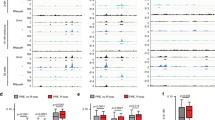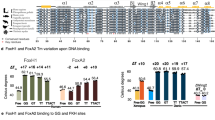Abstract
The best-characterized DNA-binding protein structure is the evolutionarily-conserved helix-turn-helix motif1–3. Recently a second motif for DNA-binding proteins, the 'zinc finger', emerged from sequence analysis of TFIIIA4, a factor involved in the control of transcription of the Xenopus 5S RNA gene. The finger structure is based on pairs of Cys and His residues which are arranged around a tetrahedrally-coordinated zinc ion4,5. This centre allows the folding of tandemly repeated 'finger loops'4 which are thought to specify the contact with target DNA. Zinc fingers have been observed in the DNA-binding protein domains of transcriptional activators in yeast6 and man (R. Tijan, personal communication) and in several regulatory proteins of Drosophila7–9 including pro-teins encoded by members of the gap class of segmentation genes8,9. One of these, Krüppel (Kr), acts at the first level of the segmentation gene hierarchy10, and its protein product may bind to DNA11. In addition, Kr is required for the development of the malpighian tubules, a posterior internal tissue that forms during later stages of embryogenesis12,13. Here we show that a mutation which results in a conservative amino-acid exchange eliminates Kr+ function. The change occurs in a key position within the putative core structure of a finger, and supports the role of Cys in metal binding as proposed by Klug and coworkers4.
This is a preview of subscription content, access via your institution
Access options
Subscribe to this journal
Receive 51 print issues and online access
$199.00 per year
only $3.90 per issue
Buy this article
- Purchase on Springer Link
- Instant access to full article PDF
Prices may be subject to local taxes which are calculated during checkout
Similar content being viewed by others
References
Pabo, C. O. & Sauer, R. T. A. Rev. Biochem. 53, 293–321 (1984).
McGinnis, W. et al. Cell 37, 403–408 (1984).
Laughon, A. & Scott, M. P. Nature 310, 25–31 (1984).
Miller, J., McLachlan, A. D. & Klug, A. EMBO J. 4, 1609–1614 (1985).
Brown, R. S., Sander, C. & Argos, P. FEBS Lett. 186, 271–274 (1985).
Hartshorne, T. A., Blumberg, H. & Young, E. T. Nature 320, 283–287 (1986).
Vincent, A. NAR 14, 4385–4391 (1986).
Rosenberg, U. B. et al. Nature 313, 336–339 (1986).
Tautz, D. et al. Nature 327, 383–389 (1987).
Akam, M. Development 101, 1–22 (1987).
Ollo, R. & Maniatis, T. Proc. natn. Acad. Sci. U.S.A. 84, 5700–5704 (1987).
Jäckle, H. et al. CSH Symp. Quant. Biol. 50, 465–473 (1985).
Gloor, H. Arch. Julius Klaus-Stift. Vererbungsforsch. 29, 277–287 (1954).
Wieschaus, E., Nüsslein-Volhard, C. & Kluding, H. Devl. Biol 104, 172–186 (1984).
Preiss, A. et al. Nature 313, 27–32 (1985).
Gaul, U., Seifert, E., Schuh, R. & Jäckle, H. Cell 50, 639–647 (1987).
Gaul, U. & Jäckle, H. Cell 51, 549–555 (1987).
Rhodes, D. & Klug, A. Cell 46, 123–132 (1986).
Petkovich, M., Brand, N. J., Krust, A. & Chambon, P. Nature 330, 444–450 (1987).
Carroll, S. B. & Scott, M. P. Cell 45, 113–126 (1986).
Blumberg, H., Eisen, A., Sledziewski, A., Bader, D. & Young, E. T. Nature 328, 443–445 (1987).
Author information
Authors and Affiliations
Rights and permissions
About this article
Cite this article
Redemann, N., Gaul, U. & Jäckle, H. Disruption of a putative Cys–zinc interaction eliminates the biological activity of the Krüppel finger protein. Nature 332, 90–92 (1988). https://doi.org/10.1038/332090a0
Received:
Accepted:
Issue Date:
DOI: https://doi.org/10.1038/332090a0
This article is cited by
-
A SALL4 zinc finger missense mutation predicted to result in increased DNA binding affinity is associated with cranial midline defects and mild features of Okihiro syndrome
Human Genetics (2006)
-
A structure-function analysis of NOD, a kinesin-like protein from Drosopbila melanogaster
Molecular and General Genetics MGG (1994)
-
Drosophila Krüppel protein is a transcriptional represser
Nature (1990)
-
Sequence-specific DNA-binding activities of the gap proteins encoded by hunchback and Krüppel in Drosophila
Nature (1989)
Comments
By submitting a comment you agree to abide by our Terms and Community Guidelines. If you find something abusive or that does not comply with our terms or guidelines please flag it as inappropriate.



